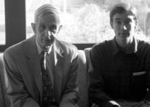John Forbes & John Charles Martin Nash
Comment from Jack R Foucher
Diagnostic hypothesis according to the WKL classification
By only using CIM / DSM semiology, the case report is not informative for a WKL diagnosis. Indeed, delusions and hallucinations are virtually observable in all endogenous psychoses.
It is actually the videos that makes possible to specify the diagnosis.
Considering John Forbes first, it seems that the pathology had a remittent progressive course. There was no evidence for any signs of neurodevelopmental involvement (clumsiness, minor neurological signs, accentuated personality, dysmorphia ...). This point towards a non-system schizophrenia. Residual symptoms were mostly on the psychomotor side: facial expressions were almost absent as well as accompanying hand movements. The absence of neuroleptic medications ruled out an extrapyramidal syndrome and there was no reason to consider a Parkinson’s disease (no mention, no left-right asymmetry). Contrasting with this apparent hypo-expressivity, JF Nash had one clearly distorted ‘grimacing’ facial expression (at the end of the interview of JF Nash and while one questions his son). Although it is not possible to ensure here that there is no coherent emotion associated with it, further grimacing could be observed in other video documents. Considering that neuroleptic treatments were scarce and that the involuntary movements weren’t repetitive and did also concern the upper face, they are unlikely to be a form of tardive dyskinesia. These are rather some “slow” form of parakinesia. Last, a lake of inner energy could be suspected from the global behavior, especially while teaching, but we miss the classical subjective account for it.
This points towards a classical residual syndrome of a periodic catatonia.
The clinical picture of John Charles Martin is even clearer. He has a marked parakinetic restlessness, with some stereotyped movements and demonstrated some impulsive behavior, i.e. especially his brusque decision to end up the interview. However, the repetitive lips-smacking movements might be considered as a tardive dyskinesia. One element for the differential diagnosis would be the insight that John Charles Martin had about them. Tardive dyskinesias are typically disturbing while parakinesias remain largely unnoticed. Last, the much earlier beginning of John Charles Martin’s symptoms (anticipation phenomenon) is a classical feature of periodic catatonia which sometime can build up to the point that children develop their first episode before the parent.
